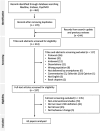Personalized interventions for behaviour change: A scoping review of just-in-time adaptive interventions
- PMID: 39542743
- PMCID: PMC11583291
- DOI: 10.1111/bjhp.12766
Personalized interventions for behaviour change: A scoping review of just-in-time adaptive interventions
Abstract
Purpose: Examine the development, implementation and evaluation of just-in-time adaptive interventions (JITAIs) in behaviour change and evaluate the quality of intervention reporting.
Methods: A scoping review of JITAIs incorporating mobile health (mHealth) technologies to improve health-related behaviours in adults. We searched MEDLINE, Embase and PsycINFO using terms related to JITAIs, mHealth, behaviour change and intervention methodology. Narrative analysis assessed theoretical foundations, real-time data capturing and processing methods, outcome evaluation and summarized JITAI efficacy. Quality of intervention reporting was assessed using the template for intervention description and replication (TIDieR) checklist.
Results: Sixty-two JITAIs across physical activity, sedentary behaviour, dietary behaviour, substance use, sexual behaviour, fluid intake, treatment adherence, social skills, gambling behaviour and self-management skills were included. The majority (71%) aimed to evaluate feasibility, acceptability and/or usability. Supporting evidence for JITAI development was identified in 46 studies, with 67% applying this to develop tailored intervention content. Over half (55%) relied solely on self-reported data for tailoring, and 13 studies used only passive monitoring data. While data processing methods were commonly reported, 44% did not specify their techniques. 89% of JITAI designs achieved full marks on the TIDieR checklist and provided sufficient details on JITAI components. Overall, JITAIs proved to be feasible, acceptable and user-friendly across behaviours and settings. Randomized trials showed tailored interventions were efficacious, though outcomes varied by behaviour.
Conclusions: JITAIs offer a promising approach to developing personalized interventions, with their potential effects continuously growing. The recommended checklist emphasizes the importance of reporting transparency in establishing robust intervention designs.
Keywords: behaviour change; digital health; just‐in‐time adaptive intervention; mobile health; personalized intervention.
© 2024 The Author(s). British Journal of Health Psychology published by John Wiley & Sons Ltd on behalf of British Psychological Society.
Figures


Similar articles
-
A systematic review of just-in-time adaptive interventions (JITAIs) to promote physical activity.Int J Behav Nutr Phys Act. 2019 Apr 3;16(1):31. doi: 10.1186/s12966-019-0792-7. Int J Behav Nutr Phys Act. 2019. PMID: 30943983 Free PMC article.
-
Exploring the Acceptance of Just-in-Time Adaptive Lifestyle Support for People With Type 2 Diabetes: Qualitative Acceptability Study.JMIR Form Res. 2025 Feb 19;9:e65026. doi: 10.2196/65026. JMIR Form Res. 2025. PMID: 39969969 Free PMC article.
-
Exploring the Feasibility of Using ChatGPT to Create Just-in-Time Adaptive Physical Activity mHealth Intervention Content: Case Study.JMIR Med Educ. 2024 Feb 29;10:e51426. doi: 10.2196/51426. JMIR Med Educ. 2024. PMID: 38421689 Free PMC article.
-
Just-In-Time Adaptive Interventions to Promote Behavioral Health: Protocol for a Systematic Review.JMIR Res Protoc. 2025 Feb 11;14:e58917. doi: 10.2196/58917. JMIR Res Protoc. 2025. PMID: 39932763 Free PMC article.
-
Beyond the current state of just-in-time adaptive interventions in mental health: a qualitative systematic review.Front Digit Health. 2025 Jan 28;7:1460167. doi: 10.3389/fdgth.2025.1460167. eCollection 2025. Front Digit Health. 2025. PMID: 39935463 Free PMC article.
Cited by
-
Real-Time Antecedents of Young Adults' Vaping and Co-Vaping of Nicotine and Cannabis: An Ecological Momentary Assessment Study.J Med Internet Res. 2025 Aug 14;27:e75695. doi: 10.2196/75695. J Med Internet Res. 2025. PMID: 40811772 Free PMC article.
-
Effectiveness of socioecological model-guided, smart device-based, and self-management-oriented lifestyle (3SLIFE) intervention on healthy lifestyles and metabolic syndrome risk in community residents: a cluster-randomized controlled trial.BMC Med. 2025 May 28;23(1):302. doi: 10.1186/s12916-025-04135-6. BMC Med. 2025. PMID: 40437540 Free PMC article. Clinical Trial.
-
Optimizing Testimonials for Behavior Change in a Digital Intervention for Binge Eating: Human-Centered Design Study.JMIR Form Res. 2025 Mar 21;9:e59691. doi: 10.2196/59691. JMIR Form Res. 2025. PMID: 40116788 Free PMC article.
-
Implementation of Behavior Change Theories and Techniques for Physical Activity Just-in-Time Adaptive Interventions: A Scoping Review.Int J Environ Res Public Health. 2025 Jul 17;22(7):1133. doi: 10.3390/ijerph22071133. Int J Environ Res Public Health. 2025. PMID: 40724199 Free PMC article. Review.
References
-
- Academy of Medical Sciences (Royaume Uni) . (2018). Multimorbidity: A priority for global health research. Academy of Medical Sciences.
-
- Bartlett Ellis, R. J. , Hill, J. H. , Kerley, K. D. , Sinha, A. , Ganci, A. , & Russell, C. L. (2019). The feasibility of a using a Smart button Mobile health system to self‐track medication adherence and deliver tailored short message service text message feedback. JMIR Form Research, 3, e13558. - PMC - PubMed
Publication types
MeSH terms
LinkOut - more resources
Full Text Sources
Medical

